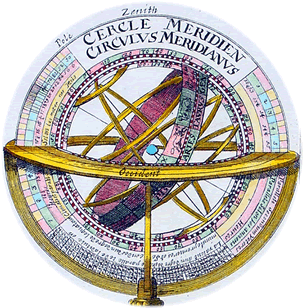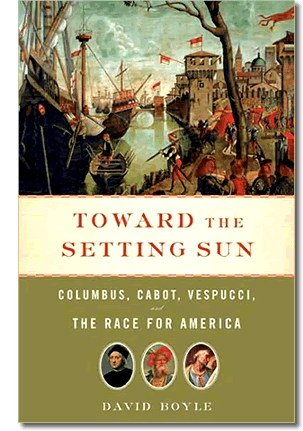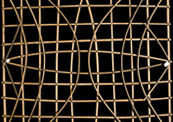John
Cabot,
Explorer:
A Tale
of a Forgotten Man
and a
Book N'er Published.
Christopher Columbus and the Great Age of Discovery
HIST 351 ~ Fall 2010
This I regard as history's highest function,
to let no worthy action be uncommemorated.
—Tacitus
By Dr. Ronald Fritze
October 14, 2010
John Cabot (c.1455-1498/1505?) is a person who earns prominent mention in history books about the early modern Age of Exploration and the beginnings of European settlement in the Americas. Looking at a name like Cabot, one might presume that the explorer was a man of impeccable WASP credentials. In fact, Cabot lived and died before the beginning of the Reformation, so the Protestant part of Cabot’s white Anglo-Saxon Protestantishness is an anachronism.
Even though he sailed on his famous voyages for England, John Cabot was Italian. Like Columbus, he appears to have come from Genoa. We know for certain that he became a citizen of Venice, no easy task to accomplish. His actual surname was Caboto. For his Christian name, he preferred the non-standard and regional Zuan to the more common Giovanni.
A Stirring Drama of Discovery
By a Player Shrouded in Obscurity
Cabot is one of those figures whose appearance on the stage of history presents a stirring drama starring a character whose nature is never fully revealed, leaving posterity with some knowledge about significant episodes in their career while hiding their complete life story in obscurity.
We know that Cabot had made his way to England by the mid-1490s. He managed to gain sponsorship from Henry VII of England for his famous voyage to North America in 1497. The next year, he sailed back to North America but what happened on that voyage has long been unclear. Most historical accounts tell us that he and his ship were lost at sea.
A portion of the Juan de la Cosa map
An alternative version of Cabot’s exploits, based on a few references to English discoveries on the Juan de la Cosa map of 1500, suggests that the explorer and his crew actually sailed down the eastern seaboard of North America and eventually made their way to Coquibaçoa on the coast of Venezuela. There Cabot encountered the Spanish explorer Alonso de Ojeda. What occurred next is uncertain. Some suggest that Ojeda either imprisoned the English or killed them. Others speculate that Ojeda informed the interlopers that they were trespassing on Spanish territory and sent them back north, where the great unknown swallowed them up.
The Cabot Saga Continues
with the Exploits of Son Sebastian.
But the Cabot saga didn’t end with John’s mysterious death. Enter onto history’s temporal stage ambitious son Sebastian.
Like his father, Sebastian Cabot was an intrepid seaman. He was also a skilled geographer and cartographer. Also like his father (and Columbus, too), Sebastian desired worldly success with hopes of parlaying his accomplishments into wealth and nobility.
John and Sebastian’s exploits occurred in a time of significant geographical confusion. The two decades following Columbus’ discoveries of 1492 were clouded by conflicting claims
 and erroneous reports based on half-truths and wilder speculation. Remember, it was the Age of Discovery and not the Age of Information. John Cabot’s achievements as an explorer may have been lost in the confusion of the times.
and erroneous reports based on half-truths and wilder speculation. Remember, it was the Age of Discovery and not the Age of Information. John Cabot’s achievements as an explorer may have been lost in the confusion of the times.
Cabot in 1497 erroneously concluded that he had reached northeast Asia, from whence he hoped to sail south to China. His second voyage in 1498 revealed his error by showing that North America was a previously unknown continent, and that his previous claims about Asia were unfounded. Other explorers quickly confirmed this discovery, although the forlorn hope that China was still near persisted until the eighteenth century.
So, Cabot had not discovered a sea route to China. Instead, he had found a massive obstacle to the long-held dream sailing west to reach China.
History's Forgotten Explorer
Is Resurrected by the Power of Scholarship.
Ever resilient, explorers quickly identified a new quest: the discovery of a way through or around the Americas on a westward path to China. Sebastian Cabot persisted in that quest, searching for a strait through the Americas, and if not that then a Northwest Passage, and if not that then a Southwest Passage. Along the way, Sebastian padded his resume with some of his father’s voyages to make himself more marketable. As a result, John Cabot faded from historical consciousness. . . . Until the inevitable course of revisionism and scholarship through archival research revealed father John’s forgotten contributions to the Age of Exploration. Since that time, historians have been seeking to reconstruct more and more of John Cabot’s life and career.
 Cabot and Columbus were not alone in suggesting the possibility of a western voyage across the Atlantic Ocean to Asia. They were also not alone in the more fundamental tasks of Atlantic Ocean exploration. Columbus and Cabot were interested in a new and more convenient way to reach Asia and its luxuries, but others were interested in developing new fishing grounds. Merchants from the English city of Bristol were definitely interested in Atlantic exploration to locate new fisheries. They appear to have made some voyages westward as early as 1480 or 1481. It is no coincidence that Cabot made his way to Bristol for his own western voyage.
The Scholarly Path to Cabot's Resurrection
Begins in the Southampton Merchant Trade.
Alwyn Ann Ruddock (1916-2005) was a pioneer of research into the long-obscured details and problems of John Cabot’s voyages as well as the western explorations of Bristol’s merchants. Studying under the great medieval historian Eileen Power, Ruddock focused on the trade of Southampton during the second half of the fifteenth century. Italian merchants were very active in Southampton at that time, so Ruddock’s research interests migrated into a study their role in Southampton’s economy. Her efforts produced the book Italian Merchants and Shipping in Southampton, 1270-1600 (Southampton: University College, 1951).
From there her next scholarly goal was to write a major work about Italian merchants in late medieval Europe. Of necessity, the project led Ruddock into archives with holdings related to Italian merchants. During the course of that research in 1965, she discovered in the papers of a Venetian family a previously unknown document concerning John Cabot’s voyages. At that point Ruddock’s scholarly interests shifted again, this time to John Cabot and the English discovery of America. Her ambition was to write a definitive work about John Cabot. She was promising to bring it out almost until the day she died in December 2005.
Although her book never appeared, Ruddock did produce several excellent scholarly articles about Cabot and related topics between 1965 and her retirement from Birkbeck College of the
 University of London in 1976 to join her husband Vernon Southward in his retirement. He painted and she researched. When Southward died in 1981, Ruddock continued her research on Cabot.
University of London in 1976 to join her husband Vernon Southward in his retirement. He painted and she researched. When Southward died in 1981, Ruddock continued her research on Cabot.
In 1992 she signed a contract with the University of Exeter Press to write a book about Cabot and America in time for the 500th anniversary of Cabot’s voyage in 1997. The University of Exeter Press even announced that the book would come out in the autumn of 1997 with the title John Cabot and the Discovery of America: The Voyages of a Fifteenth-Century Italian Adventurer. Alas, it never saw publication.
Her Plan to Publish Becomes Lost
in a Sea of Poor Health and Intellectual Hubris.
Ruddock’s original plan had been to publish a bigger book that would have gone back to the early voyages of 1480 and 1481 along with the later voyages of son Sebastian up to 1512. She appears to have gone back to that plan by 2002. At some point, Ruddock had actually completed a draft manuscript of the book. Unfortunately, she decided that the manuscript did not come up to her standards so she destroyed it and started over again. Unfortunately, failing eyesight and declining health slowed her progress on the book so that it remained unfinished at her death on 21 December 2005.
Ruddock’s will ordered that all her manuscripts, research notes, microfilms, and transcriptions were to be destroyed. She did not want anyone to finish her book and publish it posthumously. As she stated in her will, “All the work to be destroyed is entirely my own property. The expenses of the collection and revision have been paid by me without any publishers advance payment or any grant, academic or otherwise, to help pay for the collection or traveling expenses in England, Europe, and America. Nothing is to be sold or given to any other person or to any library university or other institution.” Her wishes were faithfully carried out by the executor of her will and so decades of research were lost.
An Examination of the Book Proposal
Reveals a Trove of Discovery, Speculation.
We are left to wonder what was lost with the destruction of Ruddock’s papers. We will never know for sure, but the proposal for her book on Cabot submitted to the University of Exeter Press survives and it has been analyzed by Evan T. Jones of the University of Bristol. The proposal reveals that Ruddock had either made some amazing discoveries or was engaged in some major speculation. Perhaps she had done both.
Ruddock claims to have traced Cabot to London, not Bristol, where he secured support from the Italian merchant community of the city. He was seeking to interest King Henry VII in his western voyage. According to Ruddock, a chief supporter of Cabot’s was Fra Giovanni Antonio Carbonaro of the order of the Hermit Friars of St. Augustine, who was a well-connected papal official. Ruddock also seems to have
 discovered some new information about Cabot’s abortive voyage of 1496 and a new letter discussing the voyage of 1497.
discovered some new information about Cabot’s abortive voyage of 1496 and a new letter discussing the voyage of 1497.
Most importantly, Ruddock claimed to have discovered much more information about Cabot’s final voyage of 1498. Besides stating that Fra Carbonaro and other Augustine Friars accompanied him west to do missionary work, she claims that the Friars even established a church in the Newfoundland area. Too, apparently finding additional documents about Cabot’s encounter with Ojeda at Coquibaçoa, Ruddock states that the explorer then returned first to Newfoundland with the dismal knowledge he had not found China before finally sailing back to England in 1500.
Disappointment, Embarrassment, Death
Besides failing to find a way to China, Cabot had also trespassed on Spanish waters at a time when Henry VII was engaged in negotiating a marriage alliance with Ferdinand and Isabella of Spain. Hence, Henry VII was both disappointed and embarrassed by Cabot.
According to Ruddock, Cabot died within four months of his return to England. All of this information represents a vast increase in what has hitherto been known about John Cabot’s career. But as Evan T. Jones comments, we cannot really judge how well Ruddock has proved her case unless we see her evidence.
We ask: How much was proven? How much was well-founded speculation? And how much was not-so-well founded speculation?
Furthermore, as Jones also points out, perhaps Ruddock’s failure to publish was related to her inability to prove her assertions convincingly enough for other scholars. We’ll never know because possibly one of the most revolutionary books about the Age of Exploration has been lost. Other scholars have already begun to retrace the steps of Ruddock’s Cabot research.
We Wander into Fresh Speculation
about Columbus, Cabot, and Vespucci.
In fact, Ruddock’s ideas have appeared in a recent book — David Boyle’s Toward the Setting Sun: Columbus, Cabot, and Vespucci
 and the Race for America (Walker & Company, 2008). Boyle’s book
attempts to connect the careers of Columbus, Cabot, and Vespucci into a unified story. Although the basic premise is useful, Boyle’s text also wanders onto poorly charted paths of speculation. One of his claims is that Columbus and Cabot not only knew each other but were also partners for a while prior to 1492. This claim would have been news to Ruddock as well as other historians of the Age of Exploration.
and the Race for America (Walker & Company, 2008). Boyle’s book
attempts to connect the careers of Columbus, Cabot, and Vespucci into a unified story. Although the basic premise is useful, Boyle’s text also wanders onto poorly charted paths of speculation. One of his claims is that Columbus and Cabot not only knew each other but were also partners for a while prior to 1492. This claim would have been news to Ruddock as well as other historians of the Age of Exploration.
Boyle also emphasizes a later close connection between Columbus and Vespucci. This claim is less contentious in light of a well-documented business connection between Columbus and Vespucci. Boyle also downplays any rivalry between Columbus and Vespucci, but he is hardly unique in that assertion. Most importantly, Boyle adopts Ruddock’s contentions that Cabot did return to England in 1500 after his voyage of 1498 and died soon after. Boyle’s book also provides considerable background information about European history during the late fifteen and early sixteenth centuries, which is also a good thing.
Boyle’s book is a good read but . . . .
And the “But” is a big one. Boyle makes some startling claims, the kind of historical claims that demand substantial documentation and evidence if we are to accept them with any degree of credibility. The problem is that Boyle’s book does not provide satisfactory documentation. It is not a scholarly monograph, but rather a history aimed at general readers. There are no footnotes providing documentation. Footnotes that exist are merely explanatory.
Footnotes? Back-of-the-Book Notes?
What's a Curious Scholar to Think?
Boyle’s book does provide some documentation, but it adheres to a type of surface-skimming that has become popular among publishers. Apparently, the convention among editors today adheres to a notion that footnotes are intimidating to readers. As a result, footnotes are left out. In their place we find a notes section at the back of the book referring to selected pages in the text. But even these notes are rather cursory.
Faced with an absence of footnotes numbers on pertinent pages, the reader is left to guess if documentation is provided in the back of the book. The problem becomes exaggerated when a curious reader of Toward the Setting Sun, discerning a need for documentation related to one of Boyle’s speculations, decides to consult the end notes, only to discover time and again that there are none relating to the question at hand. Result: intellectual disappointment and decreasing confidence in the reliability of the text.
Boyle admits that some of his book is speculative. He also claims that his presentation clearly differentiates between passages set on firm historical ground and passages based on speculation. His claim wasn’t borne out by my reading of the book — and on those grounds, Toward the Setting Sun is a disappointment. To an unwary reader, Boyle appears to present unproven speculation as historical fact. Let the reader beware.
Meanwhile, those of us interested the life and times of John Cabot must await another work from one of those historians who are now attempting to recreate the discoveries that Ruddock achieved and then destroyed.
Christopher Columbus and the Great Age of Discovery
HIST 351 ~ Fall 2010
Christopher Columbus and the Age of Discovery
is an internet learning resource directed by Dr. Ronald Fritze,
Dean of the College of Arts and Sciences
at Athens State University in Athens, Alabama.
The Age of Discovery web project
is part of the CornDancer family
of open-access, non-commercial, developmental websites.
|

